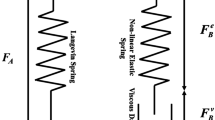Abstract
In previous works, a model was developed for the transition of an epoxy liquid to a cured solid as a result of the continuous formation of solid epoxy networks by crosslinking. The model accounts for volume decrease during crosslinking, thermal expansion due to heat generation, deformation and stress generation. The networks were assumed to be linear thermo-elastic isotropic solids, material properties were deduced from the literature, and the model was used to determine the stresses generated by curing in a number of examples. The purpose of the present work is to revisit the ideas on which this model is based and incorporate them into a general framework within the context of continuum mechanics. This will show the assumptions that have been made in the existing model because of the lack of experimental results and also provide a proper framework for extending the model as new experimental results are obtained. Each network is now assumed to be a nonlinear thermo-viscoelastic solid with its own properties. The assumption of small deformations is introduced to lead to a simplified model that is linear in the strains.
Similar content being viewed by others
References
Heinrich, C.: The influence of the curing process on the response of textile composites, Ph.D. Dissertation, University of Michigan (2011)
Heinrich, C., Aldridge, M., Wineman, A.S., Kieffer, J., Waas, A.M.: Generation of heat and stress during the cure of polymers used in fiber composites. Int. J. Eng. Sci. 53, 85–111 (2012)
Heinrich, C., Aldridge, M., Wineman, A.S., Kieffer, J., Waas, A.M., Shahwan, K.: The influence of the representative volume element (RVE) size on the homogenized response of cured fiber composites. Model. Simul. Mater. Sci. Eng. 20, 075007 (2012)
Heinrich, C., Aldridge, M., Wineman, A.S., Kieffer, J., Waas, A.M., Shahwan, K.: The role of curing stresses in subsequent response, damage and failure of textile polymer composites. J. Mech. Phys. Solids 61, 1241–1264 (2013)
Aldridge, M., Kieffer, J., Waas, A.J., Wineman, A.: In situ analysis of the relationship between cure kinetics and the mechanical modulus of an epoxy resin. Macromolecules 47, 8368–8376 (2014)
Ramakrishnan, B., Zhu, L., Pitchumani, R.: Curing of composites using internal resistive heating. J. Manuf. Sci. Eng. 122, 124–131 (2000)
Shanku, R., Vaughan, J.G., Roux, J.A.: Rheological characteristics and cure kinetics of EPON 862/W epoxy used in pultrusion. Adv. Polym. Technol. 16, 297–311 (1997)
O’Brien, D.J., White, S.R.: Cure kinetics, gelation, and glass transition of bisphenol epoxide. Polym. Eng. Sci. 43, 863–874 (2003)
Kamal, M.: Thermoset characterization for moldability analysis. Polym. Eng. Sci. 14, 231–239 (1974)
Spencer, A.J.M.: Theory of invariants. In: Eringen, A.C. (ed.) Continuum Physics, vol. 1, pp. 239–353. Academic Press, New York (1971)
Wineman, A.: Nonlinear viscoelastic solids: a review. Math. Mech. Solids 14, 300–366 (2009)
Gent, A.N.: Article 3: elasticity. In: Gent, A.N., Alan, N. (eds.) Engineering with Rubber: How to Design Rubber Components, 2nd edn. Hanser Publications, Munich (2001)
Coleman, B.D., Noll, W.: An approximation theorem for functionals with applications in continuum mechanics. Arch. Ration. Mech. Anal. 6, 355–370 (1960)
Coleman, B.D., Noll, W.: Foundations of linear viscoelasticity. Rev. Mod. Phys. 33, 239–249 (1961)
Gurtin, M.E., Sternberg, E.: On the linear theory of viscoelasticity. Arch. Ration. Mech. Anal. 11, 291–356 (1962)
Wineman, A., Rajagopal, K.R.: The Mechanical Response of Polymers. Cambridge University Press, New York (2000)
Author information
Authors and Affiliations
Corresponding author
Rights and permissions
About this article
Cite this article
Wineman, A., Heinrich, C., Nguyen, N. et al. A general network theory for the development of curing stresses in an epoxy/fiber composite. Acta Mech 227, 3585–3601 (2016). https://doi.org/10.1007/s00707-016-1675-5
Received:
Revised:
Published:
Issue Date:
DOI: https://doi.org/10.1007/s00707-016-1675-5




